3806NRS Trimester 1: Professional Practice Portfolio Assessment
VerifiedAdded on 2022/08/13
|8
|2224
|14
Report
AI Summary
This report delves into the concept of a Professional Practice Portfolio (PPP) within the nursing profession. It begins by defining a PPP and outlining its recommended components, such as curriculum vitae, records of professional development, and reflective practice guidelines. The report then presents a compelling argument for the use of PPPs, highlighting their role in demonstrating professional nursing practice, facilitating self-evaluation, and maintaining revalidation records. It critically analyzes the benefits of PPPs, including their ability to document professional growth and meet professional requirements, while also acknowledging the challenges, such as the time-consuming nature of portfolio evaluation. The report further differentiates between management and leadership concepts, illustrating how these concepts apply to the nursing field. Finally, the report applies professional standards using a scenario of ethical violation, emphasizing the importance of adhering to ethical standards of nursing practice to avoid legal implications and ensure patient safety. References from multiple sources are included to support all the claims.
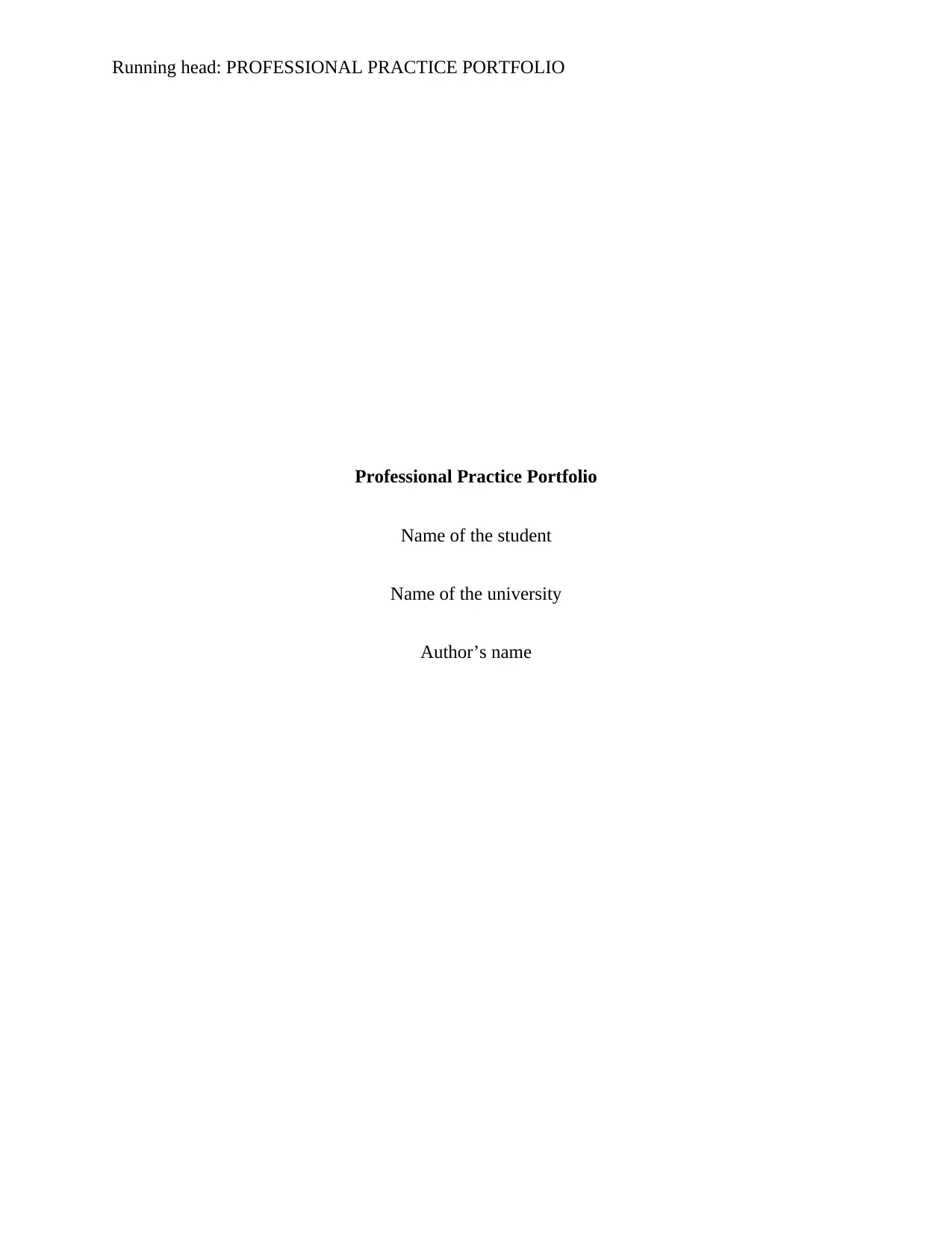
Running head: PROFESSIONAL PRACTICE PORTFOLIO
Professional Practice Portfolio
Name of the student
Name of the university
Author’s name
Professional Practice Portfolio
Name of the student
Name of the university
Author’s name
Paraphrase This Document
Need a fresh take? Get an instant paraphrase of this document with our AI Paraphraser
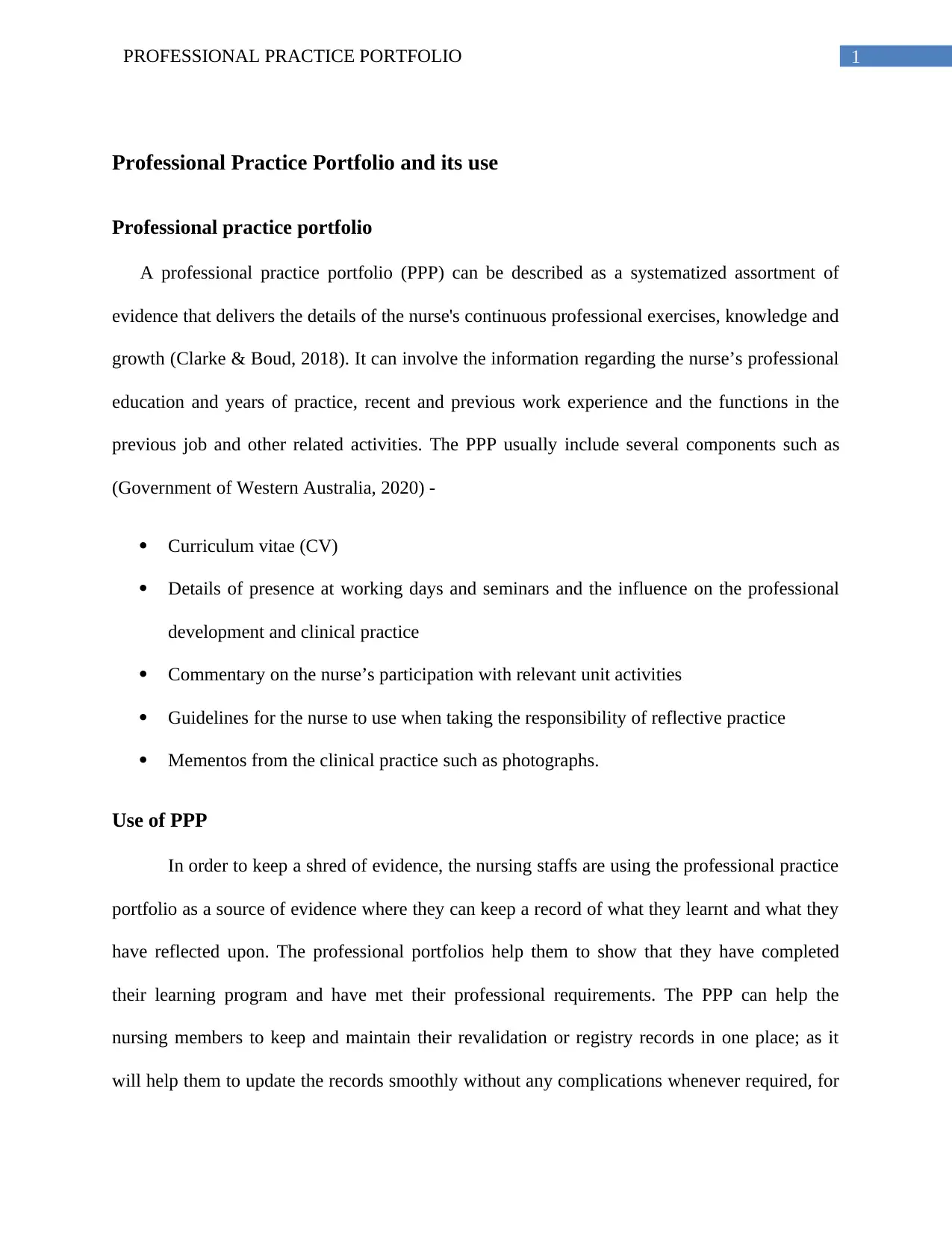
1PROFESSIONAL PRACTICE PORTFOLIO
Professional Practice Portfolio and its use
Professional practice portfolio
A professional practice portfolio (PPP) can be described as a systematized assortment of
evidence that delivers the details of the nurse's continuous professional exercises, knowledge and
growth (Clarke & Boud, 2018). It can involve the information regarding the nurse’s professional
education and years of practice, recent and previous work experience and the functions in the
previous job and other related activities. The PPP usually include several components such as
(Government of Western Australia, 2020) -
Curriculum vitae (CV)
Details of presence at working days and seminars and the influence on the professional
development and clinical practice
Commentary on the nurse’s participation with relevant unit activities
Guidelines for the nurse to use when taking the responsibility of reflective practice
Mementos from the clinical practice such as photographs.
Use of PPP
In order to keep a shred of evidence, the nursing staffs are using the professional practice
portfolio as a source of evidence where they can keep a record of what they learnt and what they
have reflected upon. The professional portfolios help them to show that they have completed
their learning program and have met their professional requirements. The PPP can help the
nursing members to keep and maintain their revalidation or registry records in one place; as it
will help them to update the records smoothly without any complications whenever required, for
Professional Practice Portfolio and its use
Professional practice portfolio
A professional practice portfolio (PPP) can be described as a systematized assortment of
evidence that delivers the details of the nurse's continuous professional exercises, knowledge and
growth (Clarke & Boud, 2018). It can involve the information regarding the nurse’s professional
education and years of practice, recent and previous work experience and the functions in the
previous job and other related activities. The PPP usually include several components such as
(Government of Western Australia, 2020) -
Curriculum vitae (CV)
Details of presence at working days and seminars and the influence on the professional
development and clinical practice
Commentary on the nurse’s participation with relevant unit activities
Guidelines for the nurse to use when taking the responsibility of reflective practice
Mementos from the clinical practice such as photographs.
Use of PPP
In order to keep a shred of evidence, the nursing staffs are using the professional practice
portfolio as a source of evidence where they can keep a record of what they learnt and what they
have reflected upon. The professional portfolios help them to show that they have completed
their learning program and have met their professional requirements. The PPP can help the
nursing members to keep and maintain their revalidation or registry records in one place; as it
will help them to update the records smoothly without any complications whenever required, for
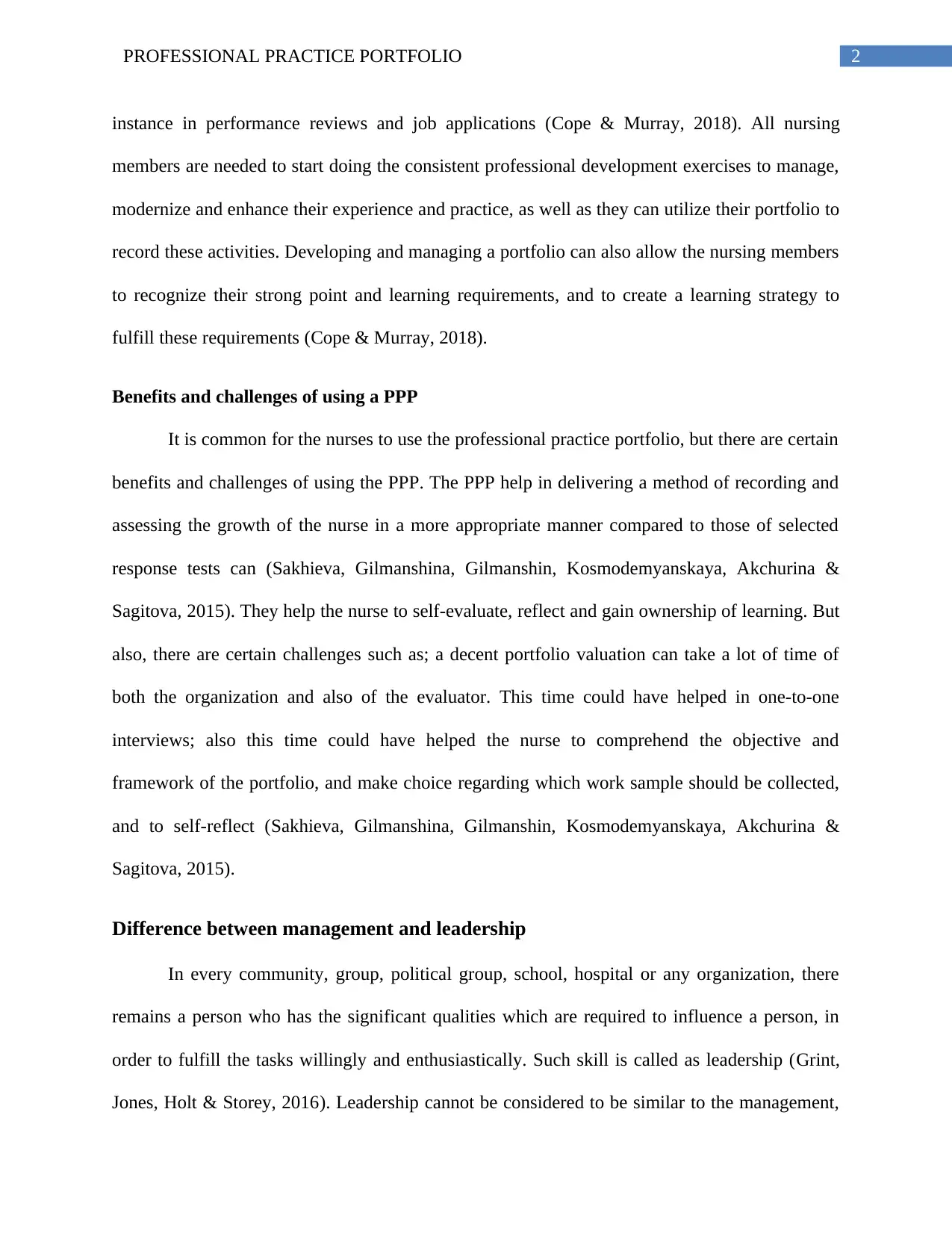
2PROFESSIONAL PRACTICE PORTFOLIO
instance in performance reviews and job applications (Cope & Murray, 2018). All nursing
members are needed to start doing the consistent professional development exercises to manage,
modernize and enhance their experience and practice, as well as they can utilize their portfolio to
record these activities. Developing and managing a portfolio can also allow the nursing members
to recognize their strong point and learning requirements, and to create a learning strategy to
fulfill these requirements (Cope & Murray, 2018).
Benefits and challenges of using a PPP
It is common for the nurses to use the professional practice portfolio, but there are certain
benefits and challenges of using the PPP. The PPP help in delivering a method of recording and
assessing the growth of the nurse in a more appropriate manner compared to those of selected
response tests can (Sakhieva, Gilmanshina, Gilmanshin, Kosmodemyanskaya, Akchurina &
Sagitova, 2015). They help the nurse to self-evaluate, reflect and gain ownership of learning. But
also, there are certain challenges such as; a decent portfolio valuation can take a lot of time of
both the organization and also of the evaluator. This time could have helped in one-to-one
interviews; also this time could have helped the nurse to comprehend the objective and
framework of the portfolio, and make choice regarding which work sample should be collected,
and to self-reflect (Sakhieva, Gilmanshina, Gilmanshin, Kosmodemyanskaya, Akchurina &
Sagitova, 2015).
Difference between management and leadership
In every community, group, political group, school, hospital or any organization, there
remains a person who has the significant qualities which are required to influence a person, in
order to fulfill the tasks willingly and enthusiastically. Such skill is called as leadership (Grint,
Jones, Holt & Storey, 2016). Leadership cannot be considered to be similar to the management,
instance in performance reviews and job applications (Cope & Murray, 2018). All nursing
members are needed to start doing the consistent professional development exercises to manage,
modernize and enhance their experience and practice, as well as they can utilize their portfolio to
record these activities. Developing and managing a portfolio can also allow the nursing members
to recognize their strong point and learning requirements, and to create a learning strategy to
fulfill these requirements (Cope & Murray, 2018).
Benefits and challenges of using a PPP
It is common for the nurses to use the professional practice portfolio, but there are certain
benefits and challenges of using the PPP. The PPP help in delivering a method of recording and
assessing the growth of the nurse in a more appropriate manner compared to those of selected
response tests can (Sakhieva, Gilmanshina, Gilmanshin, Kosmodemyanskaya, Akchurina &
Sagitova, 2015). They help the nurse to self-evaluate, reflect and gain ownership of learning. But
also, there are certain challenges such as; a decent portfolio valuation can take a lot of time of
both the organization and also of the evaluator. This time could have helped in one-to-one
interviews; also this time could have helped the nurse to comprehend the objective and
framework of the portfolio, and make choice regarding which work sample should be collected,
and to self-reflect (Sakhieva, Gilmanshina, Gilmanshin, Kosmodemyanskaya, Akchurina &
Sagitova, 2015).
Difference between management and leadership
In every community, group, political group, school, hospital or any organization, there
remains a person who has the significant qualities which are required to influence a person, in
order to fulfill the tasks willingly and enthusiastically. Such skill is called as leadership (Grint,
Jones, Holt & Storey, 2016). Leadership cannot be considered to be similar to the management,
⊘ This is a preview!⊘
Do you want full access?
Subscribe today to unlock all pages.

Trusted by 1+ million students worldwide
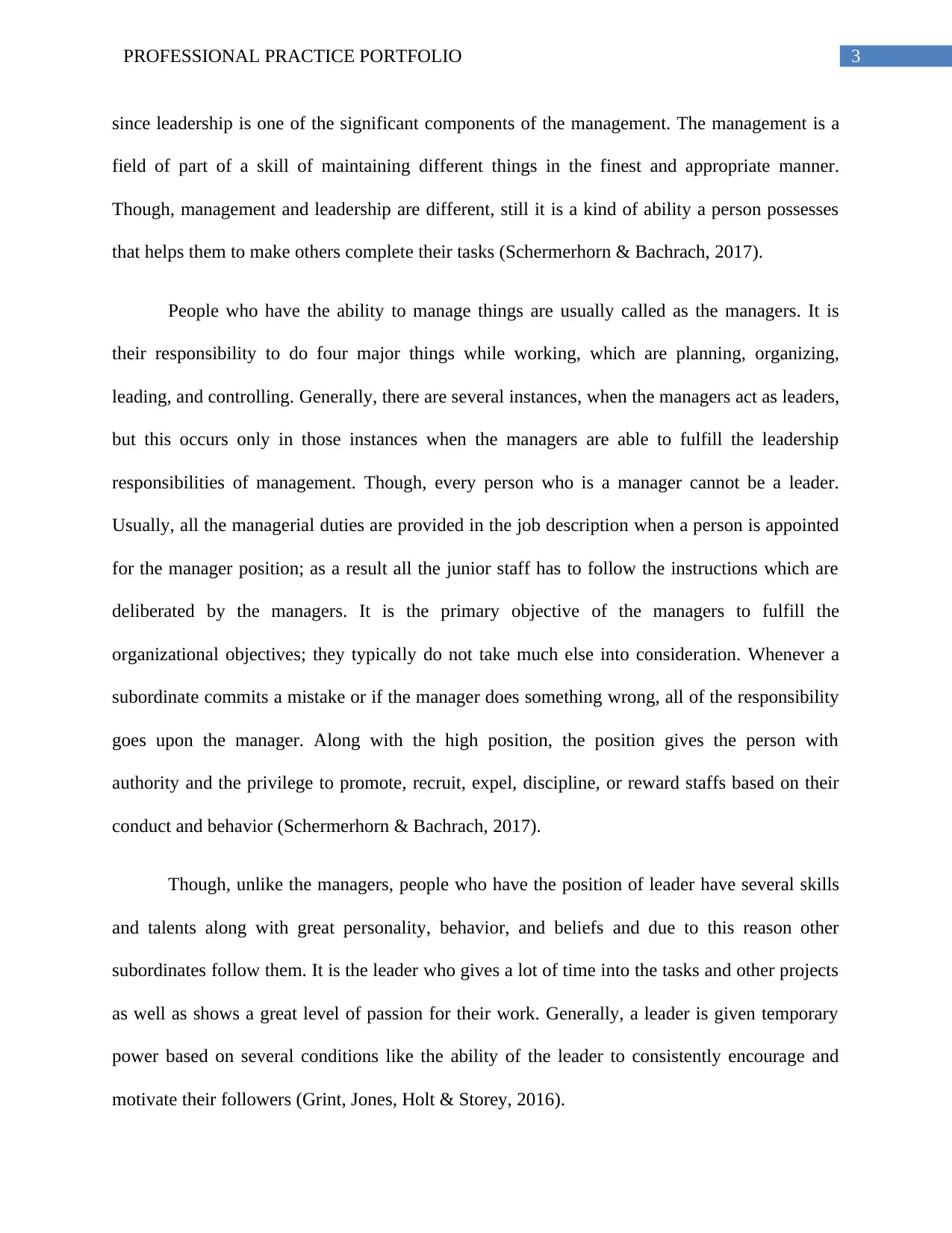
3PROFESSIONAL PRACTICE PORTFOLIO
since leadership is one of the significant components of the management. The management is a
field of part of a skill of maintaining different things in the finest and appropriate manner.
Though, management and leadership are different, still it is a kind of ability a person possesses
that helps them to make others complete their tasks (Schermerhorn & Bachrach, 2017).
People who have the ability to manage things are usually called as the managers. It is
their responsibility to do four major things while working, which are planning, organizing,
leading, and controlling. Generally, there are several instances, when the managers act as leaders,
but this occurs only in those instances when the managers are able to fulfill the leadership
responsibilities of management. Though, every person who is a manager cannot be a leader.
Usually, all the managerial duties are provided in the job description when a person is appointed
for the manager position; as a result all the junior staff has to follow the instructions which are
deliberated by the managers. It is the primary objective of the managers to fulfill the
organizational objectives; they typically do not take much else into consideration. Whenever a
subordinate commits a mistake or if the manager does something wrong, all of the responsibility
goes upon the manager. Along with the high position, the position gives the person with
authority and the privilege to promote, recruit, expel, discipline, or reward staffs based on their
conduct and behavior (Schermerhorn & Bachrach, 2017).
Though, unlike the managers, people who have the position of leader have several skills
and talents along with great personality, behavior, and beliefs and due to this reason other
subordinates follow them. It is the leader who gives a lot of time into the tasks and other projects
as well as shows a great level of passion for their work. Generally, a leader is given temporary
power based on several conditions like the ability of the leader to consistently encourage and
motivate their followers (Grint, Jones, Holt & Storey, 2016).
since leadership is one of the significant components of the management. The management is a
field of part of a skill of maintaining different things in the finest and appropriate manner.
Though, management and leadership are different, still it is a kind of ability a person possesses
that helps them to make others complete their tasks (Schermerhorn & Bachrach, 2017).
People who have the ability to manage things are usually called as the managers. It is
their responsibility to do four major things while working, which are planning, organizing,
leading, and controlling. Generally, there are several instances, when the managers act as leaders,
but this occurs only in those instances when the managers are able to fulfill the leadership
responsibilities of management. Though, every person who is a manager cannot be a leader.
Usually, all the managerial duties are provided in the job description when a person is appointed
for the manager position; as a result all the junior staff has to follow the instructions which are
deliberated by the managers. It is the primary objective of the managers to fulfill the
organizational objectives; they typically do not take much else into consideration. Whenever a
subordinate commits a mistake or if the manager does something wrong, all of the responsibility
goes upon the manager. Along with the high position, the position gives the person with
authority and the privilege to promote, recruit, expel, discipline, or reward staffs based on their
conduct and behavior (Schermerhorn & Bachrach, 2017).
Though, unlike the managers, people who have the position of leader have several skills
and talents along with great personality, behavior, and beliefs and due to this reason other
subordinates follow them. It is the leader who gives a lot of time into the tasks and other projects
as well as shows a great level of passion for their work. Generally, a leader is given temporary
power based on several conditions like the ability of the leader to consistently encourage and
motivate their followers (Grint, Jones, Holt & Storey, 2016).
Paraphrase This Document
Need a fresh take? Get an instant paraphrase of this document with our AI Paraphraser
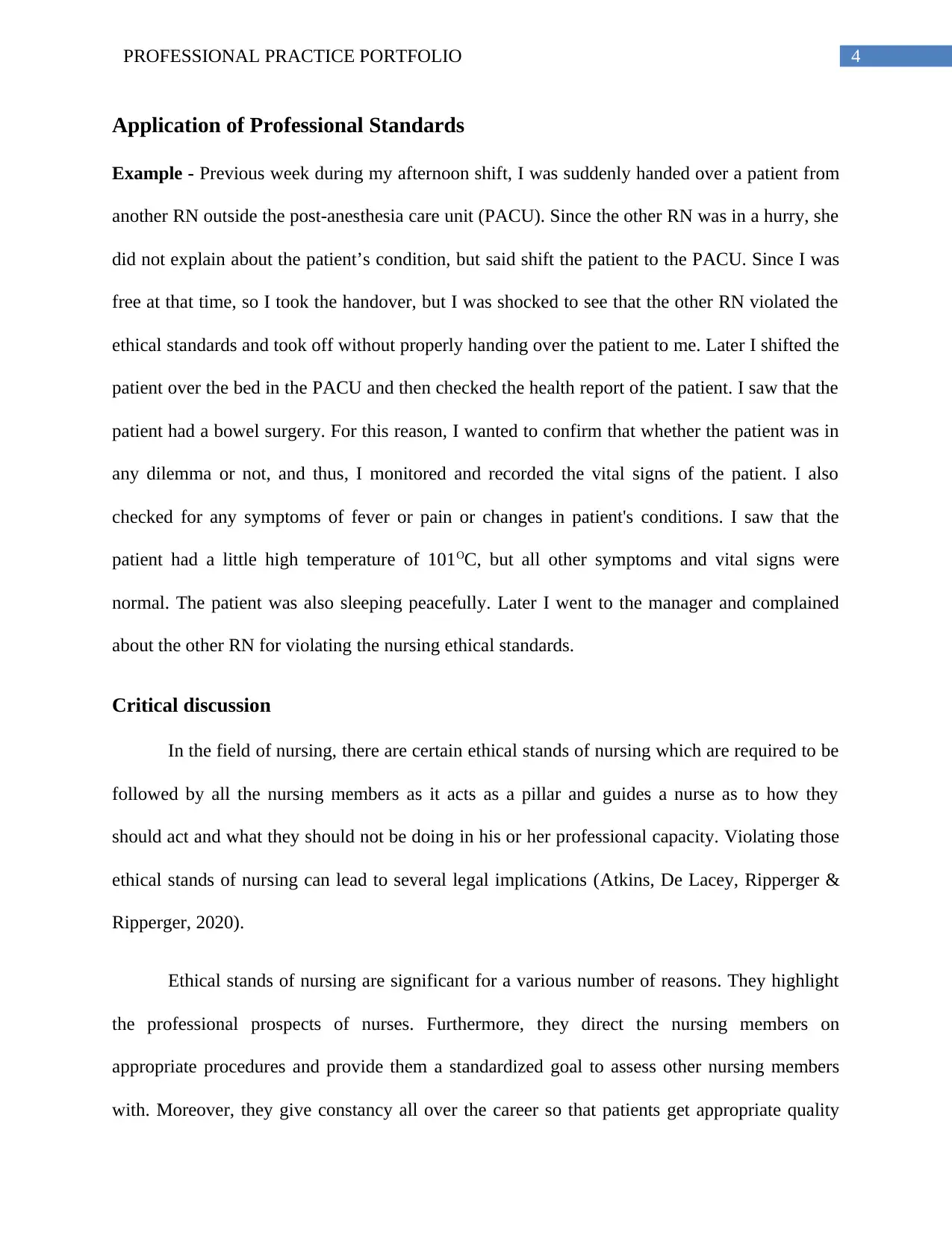
4PROFESSIONAL PRACTICE PORTFOLIO
Application of Professional Standards
Example - Previous week during my afternoon shift, I was suddenly handed over a patient from
another RN outside the post-anesthesia care unit (PACU). Since the other RN was in a hurry, she
did not explain about the patient’s condition, but said shift the patient to the PACU. Since I was
free at that time, so I took the handover, but I was shocked to see that the other RN violated the
ethical standards and took off without properly handing over the patient to me. Later I shifted the
patient over the bed in the PACU and then checked the health report of the patient. I saw that the
patient had a bowel surgery. For this reason, I wanted to confirm that whether the patient was in
any dilemma or not, and thus, I monitored and recorded the vital signs of the patient. I also
checked for any symptoms of fever or pain or changes in patient's conditions. I saw that the
patient had a little high temperature of 101OC, but all other symptoms and vital signs were
normal. The patient was also sleeping peacefully. Later I went to the manager and complained
about the other RN for violating the nursing ethical standards.
Critical discussion
In the field of nursing, there are certain ethical stands of nursing which are required to be
followed by all the nursing members as it acts as a pillar and guides a nurse as to how they
should act and what they should not be doing in his or her professional capacity. Violating those
ethical stands of nursing can lead to several legal implications (Atkins, De Lacey, Ripperger &
Ripperger, 2020).
Ethical stands of nursing are significant for a various number of reasons. They highlight
the professional prospects of nurses. Furthermore, they direct the nursing members on
appropriate procedures and provide them a standardized goal to assess other nursing members
with. Moreover, they give constancy all over the career so that patients get appropriate quality
Application of Professional Standards
Example - Previous week during my afternoon shift, I was suddenly handed over a patient from
another RN outside the post-anesthesia care unit (PACU). Since the other RN was in a hurry, she
did not explain about the patient’s condition, but said shift the patient to the PACU. Since I was
free at that time, so I took the handover, but I was shocked to see that the other RN violated the
ethical standards and took off without properly handing over the patient to me. Later I shifted the
patient over the bed in the PACU and then checked the health report of the patient. I saw that the
patient had a bowel surgery. For this reason, I wanted to confirm that whether the patient was in
any dilemma or not, and thus, I monitored and recorded the vital signs of the patient. I also
checked for any symptoms of fever or pain or changes in patient's conditions. I saw that the
patient had a little high temperature of 101OC, but all other symptoms and vital signs were
normal. The patient was also sleeping peacefully. Later I went to the manager and complained
about the other RN for violating the nursing ethical standards.
Critical discussion
In the field of nursing, there are certain ethical stands of nursing which are required to be
followed by all the nursing members as it acts as a pillar and guides a nurse as to how they
should act and what they should not be doing in his or her professional capacity. Violating those
ethical stands of nursing can lead to several legal implications (Atkins, De Lacey, Ripperger &
Ripperger, 2020).
Ethical stands of nursing are significant for a various number of reasons. They highlight
the professional prospects of nurses. Furthermore, they direct the nursing members on
appropriate procedures and provide them a standardized goal to assess other nursing members
with. Moreover, they give constancy all over the career so that patients get appropriate quality
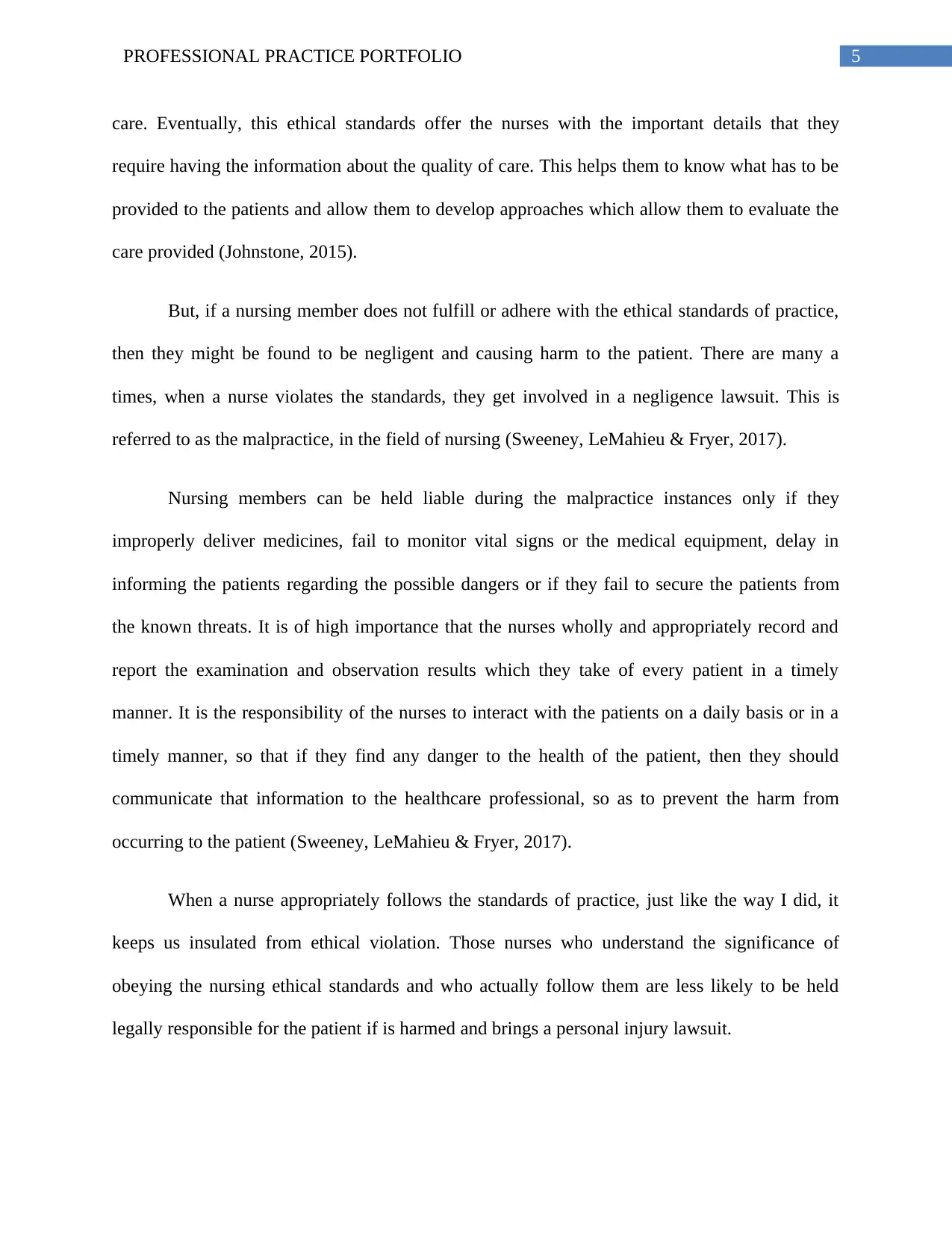
5PROFESSIONAL PRACTICE PORTFOLIO
care. Eventually, this ethical standards offer the nurses with the important details that they
require having the information about the quality of care. This helps them to know what has to be
provided to the patients and allow them to develop approaches which allow them to evaluate the
care provided (Johnstone, 2015).
But, if a nursing member does not fulfill or adhere with the ethical standards of practice,
then they might be found to be negligent and causing harm to the patient. There are many a
times, when a nurse violates the standards, they get involved in a negligence lawsuit. This is
referred to as the malpractice, in the field of nursing (Sweeney, LeMahieu & Fryer, 2017).
Nursing members can be held liable during the malpractice instances only if they
improperly deliver medicines, fail to monitor vital signs or the medical equipment, delay in
informing the patients regarding the possible dangers or if they fail to secure the patients from
the known threats. It is of high importance that the nurses wholly and appropriately record and
report the examination and observation results which they take of every patient in a timely
manner. It is the responsibility of the nurses to interact with the patients on a daily basis or in a
timely manner, so that if they find any danger to the health of the patient, then they should
communicate that information to the healthcare professional, so as to prevent the harm from
occurring to the patient (Sweeney, LeMahieu & Fryer, 2017).
When a nurse appropriately follows the standards of practice, just like the way I did, it
keeps us insulated from ethical violation. Those nurses who understand the significance of
obeying the nursing ethical standards and who actually follow them are less likely to be held
legally responsible for the patient if is harmed and brings a personal injury lawsuit.
care. Eventually, this ethical standards offer the nurses with the important details that they
require having the information about the quality of care. This helps them to know what has to be
provided to the patients and allow them to develop approaches which allow them to evaluate the
care provided (Johnstone, 2015).
But, if a nursing member does not fulfill or adhere with the ethical standards of practice,
then they might be found to be negligent and causing harm to the patient. There are many a
times, when a nurse violates the standards, they get involved in a negligence lawsuit. This is
referred to as the malpractice, in the field of nursing (Sweeney, LeMahieu & Fryer, 2017).
Nursing members can be held liable during the malpractice instances only if they
improperly deliver medicines, fail to monitor vital signs or the medical equipment, delay in
informing the patients regarding the possible dangers or if they fail to secure the patients from
the known threats. It is of high importance that the nurses wholly and appropriately record and
report the examination and observation results which they take of every patient in a timely
manner. It is the responsibility of the nurses to interact with the patients on a daily basis or in a
timely manner, so that if they find any danger to the health of the patient, then they should
communicate that information to the healthcare professional, so as to prevent the harm from
occurring to the patient (Sweeney, LeMahieu & Fryer, 2017).
When a nurse appropriately follows the standards of practice, just like the way I did, it
keeps us insulated from ethical violation. Those nurses who understand the significance of
obeying the nursing ethical standards and who actually follow them are less likely to be held
legally responsible for the patient if is harmed and brings a personal injury lawsuit.
⊘ This is a preview!⊘
Do you want full access?
Subscribe today to unlock all pages.

Trusted by 1+ million students worldwide
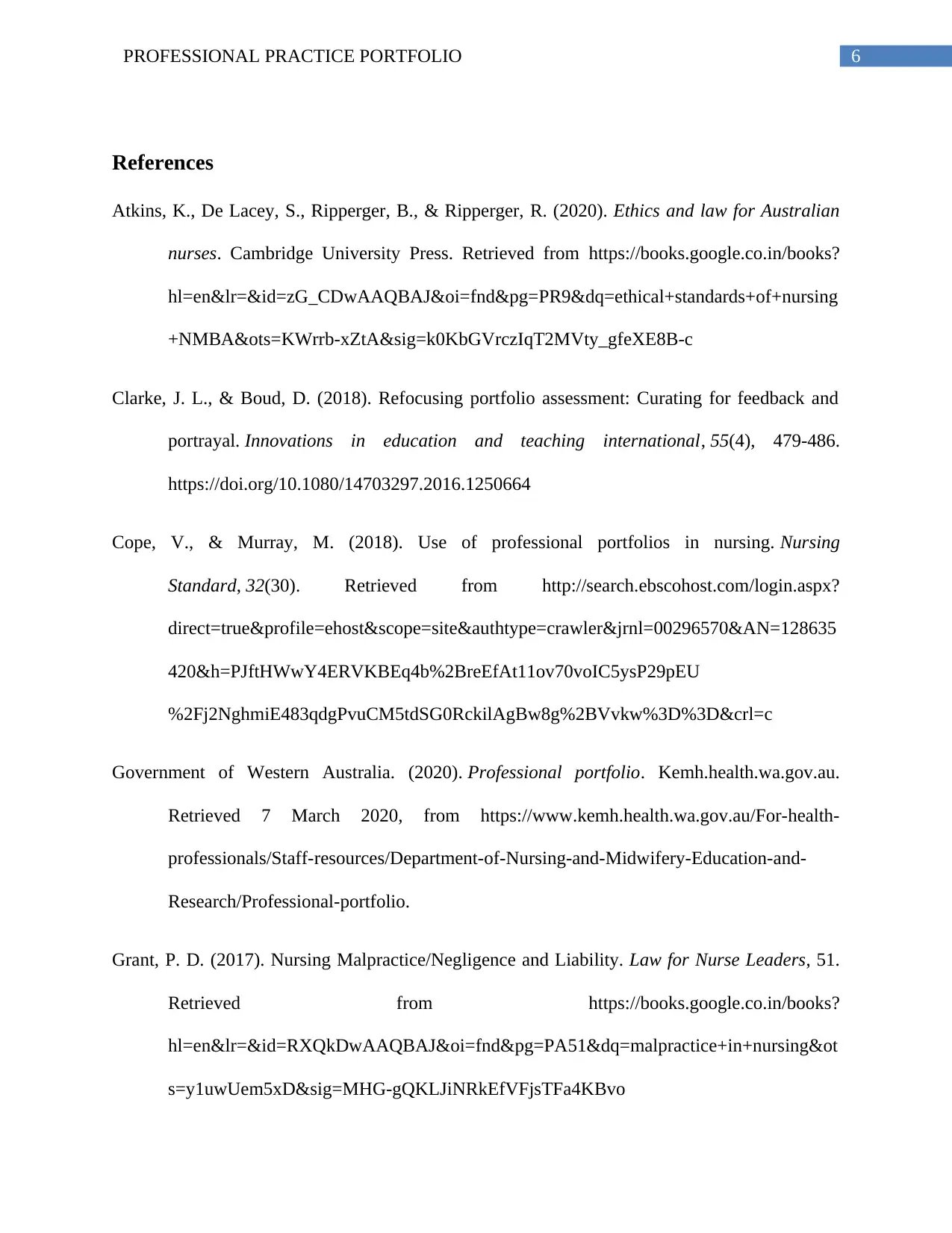
6PROFESSIONAL PRACTICE PORTFOLIO
References
Atkins, K., De Lacey, S., Ripperger, B., & Ripperger, R. (2020). Ethics and law for Australian
nurses. Cambridge University Press. Retrieved from https://books.google.co.in/books?
hl=en&lr=&id=zG_CDwAAQBAJ&oi=fnd&pg=PR9&dq=ethical+standards+of+nursing
+NMBA&ots=KWrrb-xZtA&sig=k0KbGVrczIqT2MVty_gfeXE8B-c
Clarke, J. L., & Boud, D. (2018). Refocusing portfolio assessment: Curating for feedback and
portrayal. Innovations in education and teaching international, 55(4), 479-486.
https://doi.org/10.1080/14703297.2016.1250664
Cope, V., & Murray, M. (2018). Use of professional portfolios in nursing. Nursing
Standard, 32(30). Retrieved from http://search.ebscohost.com/login.aspx?
direct=true&profile=ehost&scope=site&authtype=crawler&jrnl=00296570&AN=128635
420&h=PJftHWwY4ERVKBEq4b%2BreEfAt11ov70voIC5ysP29pEU
%2Fj2NghmiE483qdgPvuCM5tdSG0RckilAgBw8g%2BVvkw%3D%3D&crl=c
Government of Western Australia. (2020). Professional portfolio. Kemh.health.wa.gov.au.
Retrieved 7 March 2020, from https://www.kemh.health.wa.gov.au/For-health-
professionals/Staff-resources/Department-of-Nursing-and-Midwifery-Education-and-
Research/Professional-portfolio.
Grant, P. D. (2017). Nursing Malpractice/Negligence and Liability. Law for Nurse Leaders, 51.
Retrieved from https://books.google.co.in/books?
hl=en&lr=&id=RXQkDwAAQBAJ&oi=fnd&pg=PA51&dq=malpractice+in+nursing&ot
s=y1uwUem5xD&sig=MHG-gQKLJiNRkEfVFjsTFa4KBvo
References
Atkins, K., De Lacey, S., Ripperger, B., & Ripperger, R. (2020). Ethics and law for Australian
nurses. Cambridge University Press. Retrieved from https://books.google.co.in/books?
hl=en&lr=&id=zG_CDwAAQBAJ&oi=fnd&pg=PR9&dq=ethical+standards+of+nursing
+NMBA&ots=KWrrb-xZtA&sig=k0KbGVrczIqT2MVty_gfeXE8B-c
Clarke, J. L., & Boud, D. (2018). Refocusing portfolio assessment: Curating for feedback and
portrayal. Innovations in education and teaching international, 55(4), 479-486.
https://doi.org/10.1080/14703297.2016.1250664
Cope, V., & Murray, M. (2018). Use of professional portfolios in nursing. Nursing
Standard, 32(30). Retrieved from http://search.ebscohost.com/login.aspx?
direct=true&profile=ehost&scope=site&authtype=crawler&jrnl=00296570&AN=128635
420&h=PJftHWwY4ERVKBEq4b%2BreEfAt11ov70voIC5ysP29pEU
%2Fj2NghmiE483qdgPvuCM5tdSG0RckilAgBw8g%2BVvkw%3D%3D&crl=c
Government of Western Australia. (2020). Professional portfolio. Kemh.health.wa.gov.au.
Retrieved 7 March 2020, from https://www.kemh.health.wa.gov.au/For-health-
professionals/Staff-resources/Department-of-Nursing-and-Midwifery-Education-and-
Research/Professional-portfolio.
Grant, P. D. (2017). Nursing Malpractice/Negligence and Liability. Law for Nurse Leaders, 51.
Retrieved from https://books.google.co.in/books?
hl=en&lr=&id=RXQkDwAAQBAJ&oi=fnd&pg=PA51&dq=malpractice+in+nursing&ot
s=y1uwUem5xD&sig=MHG-gQKLJiNRkEfVFjsTFa4KBvo
Paraphrase This Document
Need a fresh take? Get an instant paraphrase of this document with our AI Paraphraser
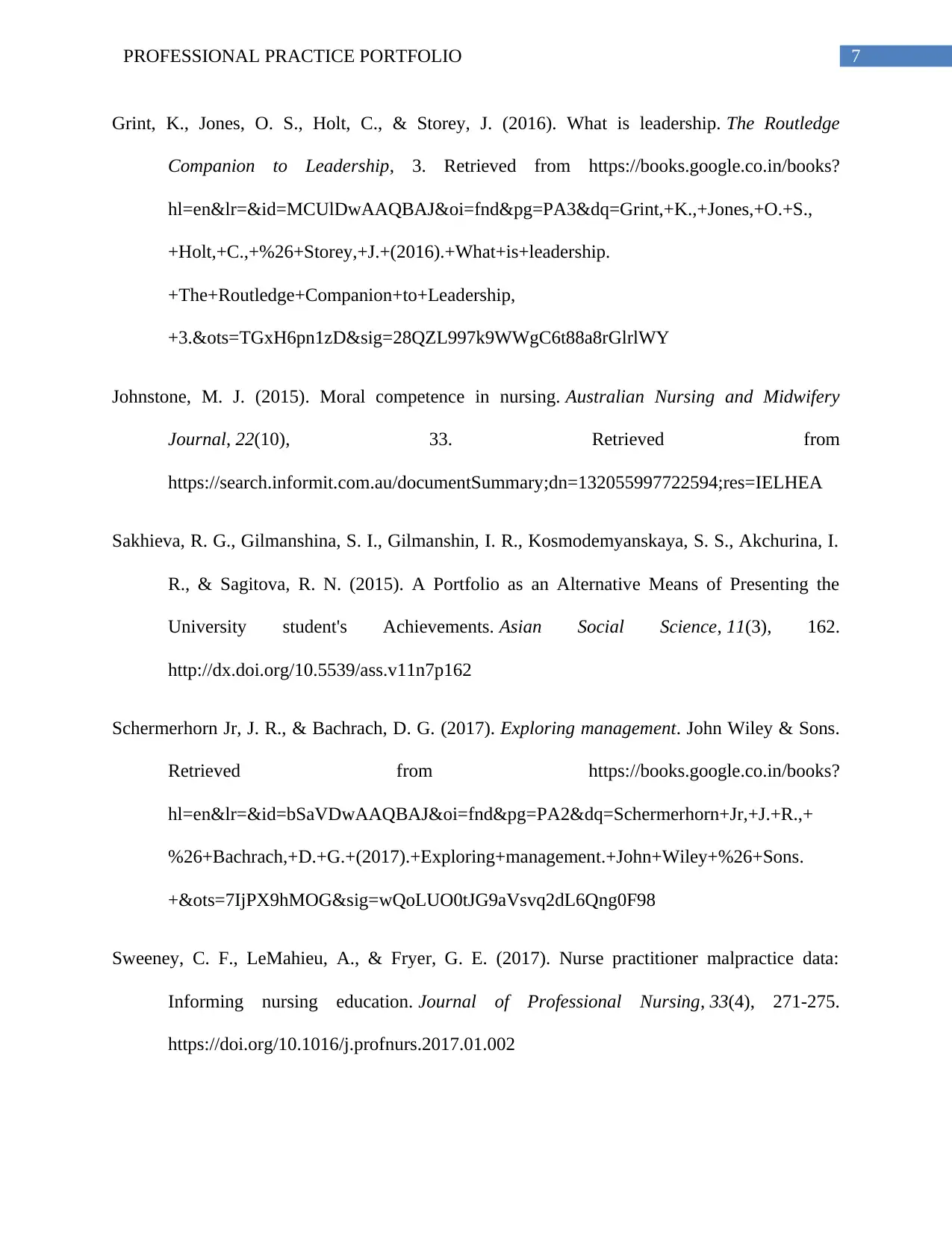
7PROFESSIONAL PRACTICE PORTFOLIO
Grint, K., Jones, O. S., Holt, C., & Storey, J. (2016). What is leadership. The Routledge
Companion to Leadership, 3. Retrieved from https://books.google.co.in/books?
hl=en&lr=&id=MCUlDwAAQBAJ&oi=fnd&pg=PA3&dq=Grint,+K.,+Jones,+O.+S.,
+Holt,+C.,+%26+Storey,+J.+(2016).+What+is+leadership.
+The+Routledge+Companion+to+Leadership,
+3.&ots=TGxH6pn1zD&sig=28QZL997k9WWgC6t88a8rGlrlWY
Johnstone, M. J. (2015). Moral competence in nursing. Australian Nursing and Midwifery
Journal, 22(10), 33. Retrieved from
https://search.informit.com.au/documentSummary;dn=132055997722594;res=IELHEA
Sakhieva, R. G., Gilmanshina, S. I., Gilmanshin, I. R., Kosmodemyanskaya, S. S., Akchurina, I.
R., & Sagitova, R. N. (2015). A Portfolio as an Alternative Means of Presenting the
University student's Achievements. Asian Social Science, 11(3), 162.
http://dx.doi.org/10.5539/ass.v11n7p162
Schermerhorn Jr, J. R., & Bachrach, D. G. (2017). Exploring management. John Wiley & Sons.
Retrieved from https://books.google.co.in/books?
hl=en&lr=&id=bSaVDwAAQBAJ&oi=fnd&pg=PA2&dq=Schermerhorn+Jr,+J.+R.,+
%26+Bachrach,+D.+G.+(2017).+Exploring+management.+John+Wiley+%26+Sons.
+&ots=7IjPX9hMOG&sig=wQoLUO0tJG9aVsvq2dL6Qng0F98
Sweeney, C. F., LeMahieu, A., & Fryer, G. E. (2017). Nurse practitioner malpractice data:
Informing nursing education. Journal of Professional Nursing, 33(4), 271-275.
https://doi.org/10.1016/j.profnurs.2017.01.002
Grint, K., Jones, O. S., Holt, C., & Storey, J. (2016). What is leadership. The Routledge
Companion to Leadership, 3. Retrieved from https://books.google.co.in/books?
hl=en&lr=&id=MCUlDwAAQBAJ&oi=fnd&pg=PA3&dq=Grint,+K.,+Jones,+O.+S.,
+Holt,+C.,+%26+Storey,+J.+(2016).+What+is+leadership.
+The+Routledge+Companion+to+Leadership,
+3.&ots=TGxH6pn1zD&sig=28QZL997k9WWgC6t88a8rGlrlWY
Johnstone, M. J. (2015). Moral competence in nursing. Australian Nursing and Midwifery
Journal, 22(10), 33. Retrieved from
https://search.informit.com.au/documentSummary;dn=132055997722594;res=IELHEA
Sakhieva, R. G., Gilmanshina, S. I., Gilmanshin, I. R., Kosmodemyanskaya, S. S., Akchurina, I.
R., & Sagitova, R. N. (2015). A Portfolio as an Alternative Means of Presenting the
University student's Achievements. Asian Social Science, 11(3), 162.
http://dx.doi.org/10.5539/ass.v11n7p162
Schermerhorn Jr, J. R., & Bachrach, D. G. (2017). Exploring management. John Wiley & Sons.
Retrieved from https://books.google.co.in/books?
hl=en&lr=&id=bSaVDwAAQBAJ&oi=fnd&pg=PA2&dq=Schermerhorn+Jr,+J.+R.,+
%26+Bachrach,+D.+G.+(2017).+Exploring+management.+John+Wiley+%26+Sons.
+&ots=7IjPX9hMOG&sig=wQoLUO0tJG9aVsvq2dL6Qng0F98
Sweeney, C. F., LeMahieu, A., & Fryer, G. E. (2017). Nurse practitioner malpractice data:
Informing nursing education. Journal of Professional Nursing, 33(4), 271-275.
https://doi.org/10.1016/j.profnurs.2017.01.002
1 out of 8
Related Documents
Your All-in-One AI-Powered Toolkit for Academic Success.
+13062052269
info@desklib.com
Available 24*7 on WhatsApp / Email
![[object Object]](/_next/static/media/star-bottom.7253800d.svg)
Unlock your academic potential
Copyright © 2020–2025 A2Z Services. All Rights Reserved. Developed and managed by ZUCOL.





